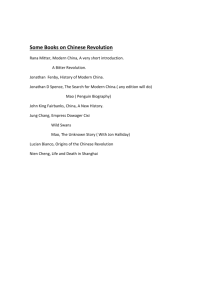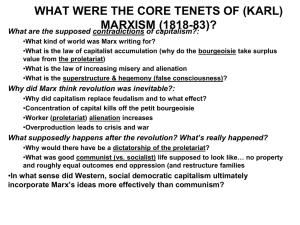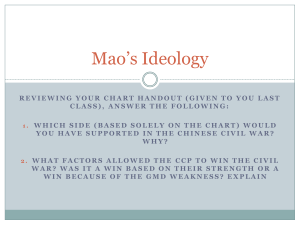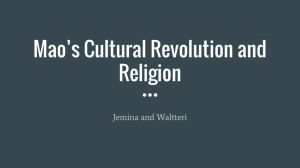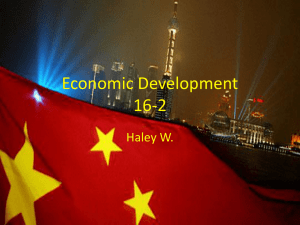accessed April 10, 2010. Activity 12. Mao Analyzes Social Classes (1926)
advertisement
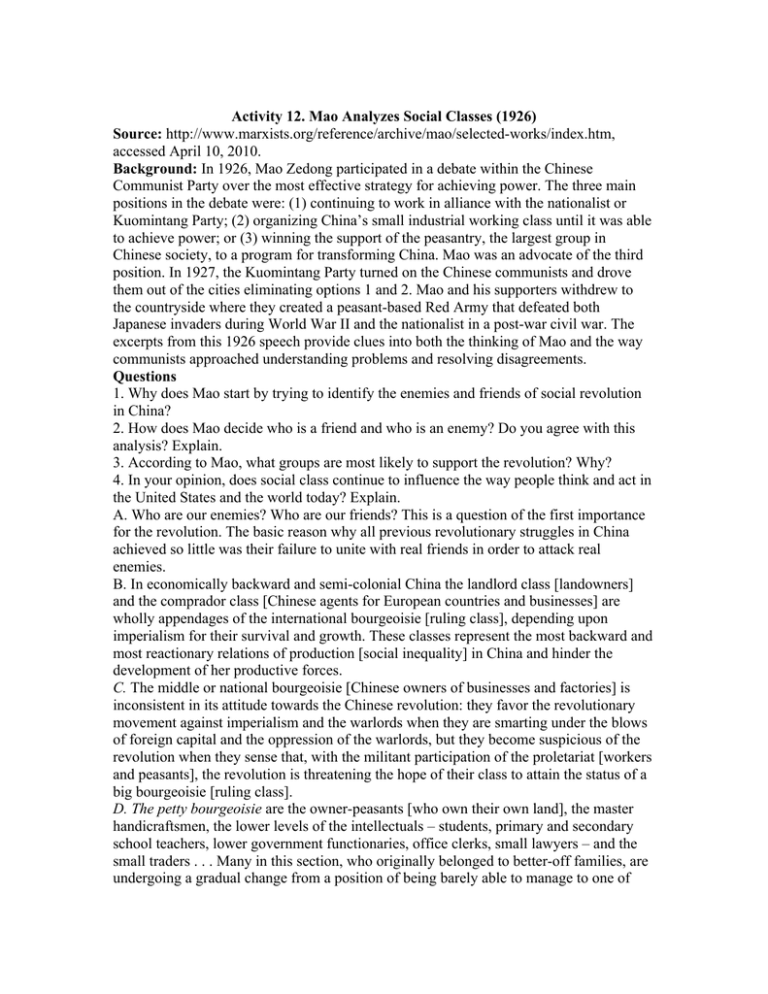
Activity 12. Mao Analyzes Social Classes (1926) Source: http://www.marxists.org/reference/archive/mao/selected-works/index.htm, accessed April 10, 2010. Background: In 1926, Mao Zedong participated in a debate within the Chinese Communist Party over the most effective strategy for achieving power. The three main positions in the debate were: (1) continuing to work in alliance with the nationalist or Kuomintang Party; (2) organizing China’s small industrial working class until it was able to achieve power; or (3) winning the support of the peasantry, the largest group in Chinese society, to a program for transforming China. Mao was an advocate of the third position. In 1927, the Kuomintang Party turned on the Chinese communists and drove them out of the cities eliminating options 1 and 2. Mao and his supporters withdrew to the countryside where they created a peasant-based Red Army that defeated both Japanese invaders during World War II and the nationalist in a post-war civil war. The excerpts from this 1926 speech provide clues into both the thinking of Mao and the way communists approached understanding problems and resolving disagreements. Questions 1. Why does Mao start by trying to identify the enemies and friends of social revolution in China? 2. How does Mao decide who is a friend and who is an enemy? Do you agree with this analysis? Explain. 3. According to Mao, what groups are most likely to support the revolution? Why? 4. In your opinion, does social class continue to influence the way people think and act in the United States and the world today? Explain. A. Who are our enemies? Who are our friends? This is a question of the first importance for the revolution. The basic reason why all previous revolutionary struggles in China achieved so little was their failure to unite with real friends in order to attack real enemies. B. In economically backward and semi-colonial China the landlord class [landowners] and the comprador class [Chinese agents for European countries and businesses] are wholly appendages of the international bourgeoisie [ruling class], depending upon imperialism for their survival and growth. These classes represent the most backward and most reactionary relations of production [social inequality] in China and hinder the development of her productive forces. C. The middle or national bourgeoisie [Chinese owners of businesses and factories] is inconsistent in its attitude towards the Chinese revolution: they favor the revolutionary movement against imperialism and the warlords when they are smarting under the blows of foreign capital and the oppression of the warlords, but they become suspicious of the revolution when they sense that, with the militant participation of the proletariat [workers and peasants], the revolution is threatening the hope of their class to attain the status of a big bourgeoisie [ruling class]. D. The petty bourgeoisie are the owner-peasants [who own their own land], the master handicraftsmen, the lower levels of the intellectuals – students, primary and secondary school teachers, lower government functionaries, office clerks, small lawyers – and the small traders . . . Many in this section, who originally belonged to better-off families, are undergoing a gradual change from a position of being barely able to manage to one of living in more and more reduced circumstances . . . They are in great mental distress because there is such a contrast between their past and their present. Such people are quite important for the revolutionary movement. E. The semi-owner peasants are more revolutionary than the owner-peasants, but less revolutionary than the poor peasants. The poor peasants are tenant-peasants who are exploited by the landlords . . . They are the worst off among the peasants and are highly receptive to revolutionary propaganda. The small handicraftsmen . . . feel the constant pinch of poverty and dread of unemployment, because of heavy family burdens and the gap between their earnings and the cost of living; in this respect too they largely resemble the poor peasants. F. The modern industrial proletariat [working class] numbers about two million. It is not large because China is economically backward. These two million industrial workers are mainly employed in five industries – railways, mining, maritime transport, textiles and shipbuilding – and a great number are enslaved in enterprises owned by foreign capitalists. Though not very numerous, the industrial proletariat represents China’s new productive forces, is the most progressive class in modern China and has become the leading force in the revolutionary movement. G. There is the fairly large lumpen [marginal] proletariat, made up of peasants who have lost their land and handicraftsmen who cannot get work. They lead the most precarious existence of all. H. Our enemies are all those in league with imperialism – the warlords, the bureaucrats, the comprador class, the big landlord class and the reactionary section of the intelligentsia attached to them. The leading force in our revolution is the industrial proletariat. Our closest friends are the entire semi-proletariat and petty bourgeoisie. As for the vacillating middle bourgeoisie, . . . we must be constantly on our guard and not let them create confusion within our ranks.
